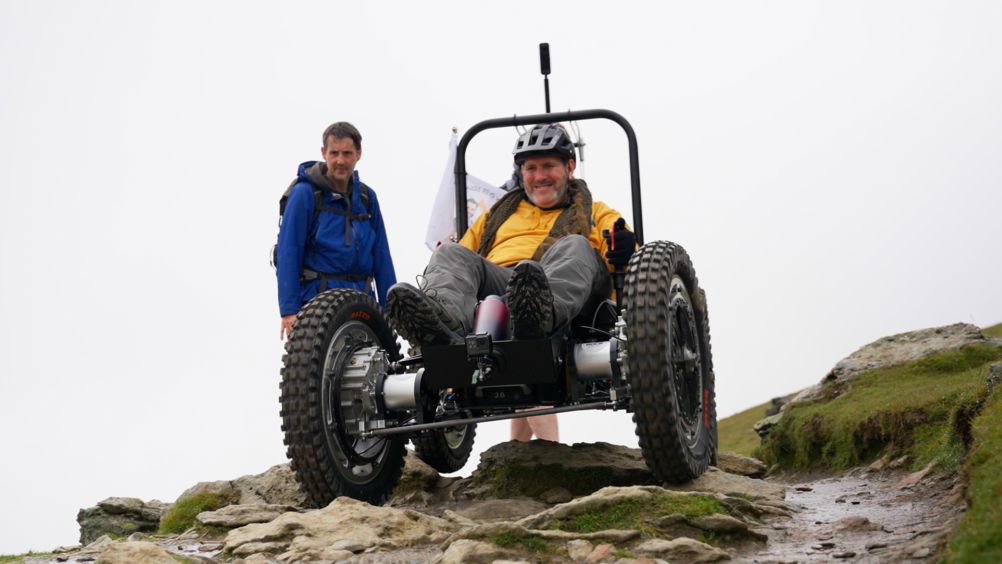Project RockClimber started through a chance encounter with disabled adventurer Nick Wilson back in mid-2022. Nick wanted to highlight just how difficult access is to both the countryside, and urban environments, as a wheelchair user. He had big plans for him, and his power chair – and he mentioned that his real wish was to try and climb Mount Snowdon.
I knew the Llanberis Path was considered the “simpler” route, so Andrew (co-owner) and I set out one October day in 2022 with the mindset of “could Nick drive his current powerchair up this path”. The Llanberis route is a fantastic, well managed, route to the summit, but we quickly realised that this would be impossible in a wheelchair.
There are numerous impassible sections, with sustained gradients over 30degs, and individual steps up to 500mm. After a short discussion with Nick, we agreed we had to give creating a new machine a go – and project RockClimber was born.
Inclusive Design
We started with a blank piece of paper and a GPS log of our walk up the mountain. We needed to develop a full design specification which began with defining the fundamental mathematical problem, i.e. what energy will it take to shift Nick up 1085m, and from there we cascaded out the problem by looking at the climb profile generated by the GPS data.
We set ourselves a time goal, a maximum step capability, and an estimation for the available grip – and from there we were able to form the performance parameters for our vehicle. It became clear that our key performance targets would be torque, grip, weight and available energy. Researching the market revealed that no pre-existing power chair came close to our requirements. There are great machines out there, but we needed to create a mountaineer, not a trail runner.

Nick spent many hours in the factory, with the team discussing ideas, his specific needs, and getting measured up to make sure RockClimber’s performance was maximised. Inadvertently we were practicing Inclusive Design - considering the end user’s own comfort and ergonomics to incorporate into the design – and it made such a difference. There is no point in creating the most capable machine or product if the consumer can only spend five minutes using it.
RockClimber features:
- Stability: The centre of mass is kept low and positioned to maintain tyre load. The wheelbase can extend 400mm rearward for extremely steep terrain, maintaining stability at climb angles greater than 60 degrees.
- Traction: The vehicle has an electric four-wheel drive system to maximise traction. The system can bias torque as the climb angle increases. Reducing sprung mass and increasing un-sprung mass, coupled with a custom high-articulation suspension, maintains higher tyre loads for improved traction.
- Torque: One of its biggest strengths is its 1600Nm of torque. Its custom 100:1 reduction gearbox allows for extremely high levels of torque from low power, high efficiency electric motors. It can achieve 6kph, whether on the flat or climbing, on a 40-degree slope. In that situation, our biggest challenge would be the safety team trying to keep up with Nick!
For testing, our target was August 2023, and the reality was March 2024. Through this we progressively increased distance and complexity, and by June 2024 we were ready for our first attempt on Snowdon. Our only issue at this point was a failed steering shaft. Those failures were analysed, Finite Element Analysis models were revised, and stronger components were made.
None of us quite realised how difficult this challenge was. It was only when we were at the bottom of Alt Moses – a notoriously difficult section on the Llanberis Path – did the enormity of this challenge hit. Many on-lookers said it was not possible.
On this first attempt, just 50m from clearing the Alt Moses steps, we broke the steering again. It was a devastating moment, but after safely extracting ourselves from the mountain (an adventure in itself), we resolved to try again, and soon.

Following the steering issues, and after a further redesign, we used load testing facilities at Aston University to quantify the improvements made. In this instance we were able to show the steering strength improved by a factor of 5 – this gave a lot of confidence. On Friday 12 July, despite the typical British weather, the RockClimber team made a final attempt on Snowdon, and after three challenging hours, Nick reached over 1020m to the highest accessible point – setting a precedent for an unaided attempt in a powerchair on Snowdon.
What’s next?
This challenge demonstrates what can be possible with the right amount of engineering and inclusive design – but powerchair adventuring is something that should be accessible to everyone. I can’t speak on behalf of powerchair users, but our intention is to show that with the right focus, it is possible to improve the accessibility and mobility of powerchairs. The term ‘inclusive engineering’ was new to me two years ago, but it is the fundamental design approach that should be used for all new products.











Water Sector Talent Exodus Could Cripple The Sector
Maybe if things are essential for the running of a country and we want to pay a fair price we should be running these utilities on a not for profit...